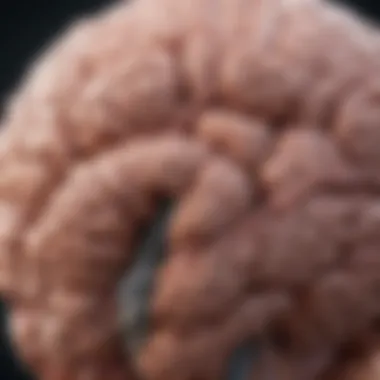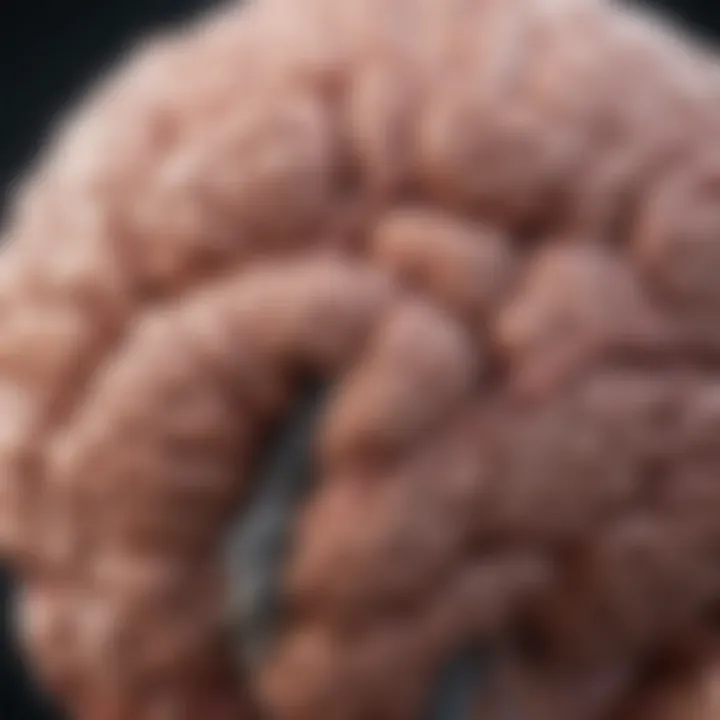Understanding Phantom Smells in Brain Tumor Patients


Intro
The human brain, a marvel of biological engineering, hides countless mysteries. Among them, the connection between brain tumors and phantom smells—commonly referred to as phantosmia—merits careful investigation. In essence, phantosmia involves perceiving odors that are not present in the environment. This seemingly innocuous sensory disturbance can hint at deeper neurological issues when associated with brain tumors.
In the quest to understand how tumors affect our sensory perceptions, researchers have begun to peel back the layers of complexity surrounding olfactory disturbances. As we unearth these relationships, we tread onto an intricate path that integrates various scientific disciplines—from neurology and psychology to oncology.
Research Context
Background and Rationale
Phantom smells can arise from several underlying causes, but their connection to brain tumors stands out due to its clinical implications. Brain tumors can disrupt normal brain function, particularly in regions responsible for processing sensory information, like the olfactory bulb. Understanding this link is crucial, not just for academic purposes, but also for improving patients' quality of life and treatment strategies.
The rationale for this exploration lies not only in the biological mechanisms involved but also in the psychological toll that such sensory disorders can impose. An individual experiencing phantosmia may face mental distress, confusion, and even stigmatization from those around them. For clinicians and caregivers, understanding these nuances will enhance the holistic care approach for patients affected by brain tumors.
Literature Review
Despite the incremental progress made in the field, a considerable gap remains in literature regarding phantom smells specifically linked to brain tumors. Most studies predominantly focus on the tumor types, treatments, and general neurological side effects, leaving the olfactory disturbances largely unexplored.
Research has indicated that the implications of sensory disturbances, such as phantosmia, can be profound. A study in the Journal of Neurology suggested that about 10% of patients with tumors affecting the temporal lobe report olfactory hallucinations. Nevertheless, comprehensive analyses of how these symptoms correlate with tumor characteristics or patient outcomes are scarce. Thus, there exists a pressing need to deepen our understanding through rigorous research.
Methodology
Research Design
In addressing the multifaceted relationship between brain tumors and phantom smells, a mixed-method approach is often beneficial. Integrating quantitative and qualitative data allows for a more nuanced understanding of patients' experiences. Surveys capturing patients' sensory perceptions can be complemented by neurological assessments and imaging studies to provide robust data.
Data Collection Methods
To delve deeper into this subject, the following data collection methods may be employed:
- Patient Surveys: Gathering self-reported experiences regarding any phantom smells and their emotional and psychological impacts.
- Neurological Assessments: Conducting comprehensive examinations to evaluate brain function and sensory processing.
- Imaging Studies: Utilizing MRI or PET scans to explore tumor locations and their potential interference with olfactory pathways.
Researching this area will not only enhance our understanding of the intricate relationship between brain health and sensory perception but also pave the way for better diagnostic and treatment avenues tailored to those whose lives are affected by these complex conditions. Through a collaborative effort, combining neurology, psychiatry, and oncology, we can uncover vital connections that influence patient care.
Prologue to Phantom Smells
Phantom smells, clinically termed phantosmia, represent a curious intersection between perception and neurological health. These odors often arise without any external source, leaving individuals confused or concerned about their well-being. The complexities of this phenomenon warrant careful examination, especially as they may serve as an early signal of underlying medical conditions, including brain tumors.
Delving into phantom smells provides a valuable perspective on how our minds interpret sensory information and the potential implications for diagnosis and treatment. Understanding this can not only improve patient outcomes but also enrich the knowledge base for both clinicians and researchers. The importance of this exploration cannot be overstated since it hinges directly on the intricate workings of the olfactory system and its vulnerabilities, which can be impacted by anomalies in the brain.
Definition of Phantom Smells
Phantom smells are defined as the perception of smells that aren't present in the environment. These occurrences can be persistent or intermittent and range from pleasant aromas to foul odors. In many cases, individuals might believe they are experiencing a scent that is localized, only to find that others do not perceive the same smell. This can lead to significant distress and confusion, impacting an individual's daily life.
Some common reported phantom smells include:
- Burning odors
- Chemical scents
- Foul or rotten smells
Phantom smells can manifest due to a variety of underlying factors. These can include previous infections, neurological disorders, or even exposure to certain medications. Moreover, in some cases, phantom smells may persist without any identifiable cause, leading to frustration for both patients and healthcare providers.
Olfactory System Overview
The olfactory system, responsible for our sense of smell, is a finely tuned network of neurons and pathways that begins in the nasal cavity. Here are some key components worth noting:


- Olfactory Receptors: Located in the nasal epithelium, these receptors interact with odor molecules and send signals to the brain.
- Olfactory Bulb: Once activated, signals travel to this region of the brain, which acts as the first site for processing smell information.
- Limbic System: Integral for emotional responses, this part is where many bite the dust of our memories connected to certain smells.
The functioning of this system can be influenced by various factors, including aging, trauma, and notably, neurological damage, which might result in interpretations that lead to phantom scents. It’s crucial to recognize that when any segment of this network encounters dysfunction, the result can often lead to altered or distorted perceptions of smells. Observing these changes can yield insights into broader health issues, such as brain tumors, thereby underscoring the significance of understanding phantom smells within a clinical setting.
Understanding Brain Tumors
Understanding brain tumors is crucial in exploring their connection to olfactory disorders, specifically phantom smells. Awareness of this topic brings forth several vital components. First, it sheds light on how different tumors can impact brain function, which in turn affects sensory perception.
When dissecting brain tumors, one quickly realizes that the brain is a complex organ, and each region holds specific responsibilities. For instance, tumors located in the temporal lobe may interfere with the limbic system, directly influencing the sense of smell. Recognizing this interaction is paramount for clinicians and researchers alike. Such knowledge can pave the way for better diagnostic processes and potentially lead to more effective treatments.
Additionally, understanding brain tumors encompasses awareness of the varying types and their symptoms. This knowledge can empower patients and their families as they navigate the emotional and physical challenges presented by such diagnoses. A detailed grasp of the implications of specific tumor types on olfactory functions can also guide therapeutic approaches. For instance, patients might present with olfactory hallucinations due to increased pressure on the olfactory bulb. Furthermore, knowledge about tumor grading and staging assists healthcare providers in tailoring treatment plans, promoting better patient outcomes.
In our quest to understand brain tumors, it’s also vital to recognize the interplay between psychological aspects and Neurological health. Patients faced with the stigma of brain tumors often experience heightened anxiety or depression. A holistic approach towards the treatment of these individuals can improve their quality of life considerably. This integration of physiological and psychological perspectives is not just beneficial; it’s necessary.
To sum it up, a deep dive into the world of brain tumors provides essential insights into their biological mechanisms, impact on sensory systems, and the human condition overall. Grasping these elements enriches our understanding of the neurological basis for phantom smells, which can significantly enhance patient care and elevate the discourse surrounding these complex conditions.
Mechanisms of Phantom Smells
Understanding the mechanisms behind phantom smells is crucial in uncovering how brain tumors may influence olfactory experiences. Phantosmia, commonly referred to as phantom smells, implicates a complex interplay of neurological processes and environmental interactions. The significance of this section lies not only in elucidating the biological basis of these sensations but also in appreciating their implications for diagnosis and management of patients with brain tumors. Here, we will delve into the neurological pathways involved and examine how other neurological disorders relate to phantom smells.
Neurological Pathways Involved
The pathways that govern our olfactory sense are intricate. When the olfactory receptors in the nose pick up scents, signals travel through the olfactory bulb and then to various areas of the brain, including the limbic system and cerebral cortex. This cascade of neural activity allows us to recognize and interpret smells, crafting a vivid environment based on scent.
In cases of phantom smells, however, this process doesn’t operate as it should. Sometimes, the olfactory bulb can misfire or generate signals independently of actual stimuli. Such disturbances can arise from various causes, including:
- Brain tumors: Neoplasms can disrupt normal function and signal pathways.
- Neurodegenerative diseases: Conditions like Alzheimer's may alter perception in unexpected ways.
- Head injuries: Trauma can lead to altered olfactory perceptions due to damage.
- Infections: Viral infections have been noted to impact the olfactory system.
To illustrate, a patient might experience aromas that are either non-existent or unpleasant. Those fragrances can lead to significant distress, complicating not only quality of life but also making a case for further examination.
Early detection and understanding of such phantom experiences linked to brain function abnormality can guide clinicians to pinpoint underlying conditions. They pave the way for better-targeted therapies that address not only the tumor but also the symptom of phantom smell itself.
Phantom Smells in Neurological Disorders
Phantom smells are frequently reported amongst patients with various neurological disorders. Being aware of this phenomenon can indeed improve diagnostic accuracy and patient care. It's worth noting that not all cases of phantom smells are caused exclusively by brain tumors. Other disorders like epilepsy or schizophrenia can also lead to olfactory hallucinations.
- Epilepsy: Individuals experiencing temporal lobe seizures might report unusual smells preceding an episode, known as an aura. These could be perceived as pleasant, foul, or even none at all.
- Schizophrenia: This mental disorder may manifest in sensory disruptions, affecting reality perception, including olfactory experiences. A person might smell something that isn't there, causing confusion.
- Multiple Sclerosis: This chronic illness can lead to a variety of sensory disruptions, including abnormal smell experiences.
Olfactory disturbances, particularly when tied to neurological conditions, can serve as indicators of underlying pathologies. Understanding these aspects enriches our grasp of how brain tumors and phantom smells intersect, allowing healthcare practitioners to devise more effective treatment protocols.
"Phantom smells provide a unique window into the workings of the brain, reflecting both the complexities of our sensory experiences and the potential disruptions caused by neurological conditions."
This rich tapestry of information regarding the mechanisms of phantom smells not only sheds light on individual patient experiences but also illustrates a broader landscape that warrants comprehensive exploration.
The Link Between Brain Tumors and Phantom Smells
Understanding the connection between brain tumors and phantom smells, also known as phantosmia, is essential in the field of neurology and mental health. This intricate relationship not only sheds light on how brain tumors can distort the senses, particularly those related to smell, but it also emphasizes the importance of accurate diagnosis and patient care. Phantom smells can manifest as various odors, often unpleasant, and their presence may indicate underlying neurological issues, including the potential existence of a brain tumor.
When considering patients with brain tumors, awareness is critical. Smell disturbances might not just be a random occurrence but a signal of deeper neurological disturbances. By investigating this link, healthcare providers can better address the symptoms and potentially improve the quality of life for patients.
"New scents in the mind ain’t just figments; they can be windows into brain health."
Case Studies Involving Olfactory Disturbances
Several case studies illuminate the relationship between brain tumors and olfactory disturbances. One notable instance involved a 45-year-old male who began experiencing the distinct scent of burnt toast. Initially dismissing the smell as a kitchen mishap, he later sought medical attention when the odor persisted, disrupting his daily life. Further investigation revealed a temporal lobe tumor, a region associated closely with the olfactory pathway. This case underscores the need to pay attention to unusual sensory experiences, as they might indicate a larger health issue.
The presence of phantom smells in another patient, a 62-year-old female, showcased a different flavor of distress. She reported smelling decaying fish, which caused significant anxiety and isolation. Medical assessments led to a diagnosis of glioblastoma multiforme, a type of aggressive brain tumor. Her story highlights how crucial early diagnosis is and how understanding these symptoms can facilitate better planning in treatment and support mechanisms.


These cases not only provide anecdotes but also highlight the importance of integrating patient reports of sensory anomalies into the diagnostic process. The persistence of phantom smells acts as a potential warning system, alerting both patients and clinicians to the possible presence of neurological conditions.
Research Findings and Trends
Recent research trends have showcased a growing interest in the phenomena of phantom smells associated with brain tumors. Studies have indicated that anywhere between 30% to 50% of patients with primary brain tumors report olfactory hallucinations at some point during their illness. This prevalence raises the question of whether olfactory disturbances might be more predictive of certain types of tumors, particularly those affecting the frontal and temporal lobes.
One significant finding suggested that patients with temporal lobe gliomas frequently experience phantom smells distinctively related to emotional states or past memories, further complicating their clinical profile. This emotional link relating to scent perception can be crucial. Healthcare providers should appreciate the complexity of these experiences, as they might influence patients’ psychological states and, in turn, their treatment responses.
Moreover, ongoing studies explore the neurological mechanisms underpinning phantom smells, focusing on the olfactory bulb and its connection to cortical regions. Researchers aim to understand how the presence of a tumor can disrupt normal olfactory processing, potentially leading to these undesirable perceptions.
As our understanding of the connection between brain tumors and phantom smells evolves, continued research is pivotal. It not only aids in refining diagnostic criteria but also encourages interdisciplinary collaboration, which could lead to more comprehensive care strategies tailored to individual patient needs.
Diagnostic Approaches
When addressing the intricate connection between brain tumors and phantom smells, the subject of diagnostic approaches is paramount. Effective identification of these phenomena not only leads to timely medical intervention, but also offers insights into the broader implications of neurological disturbances that can dramatically affect a patient's quality of life.
Clinical Assessments of Phantom Smells
A comprehensive clinical assessment is the first step in understanding phantom smells, an experience known as phantosmia. Medical professionals often begin with a detailed patient history, which includes questions about the nature of the olfactory disturbances—such as the type of smells experienced, their frequency, and any associated symptoms like headaches or seizures.
During clinical evaluations, neurologists will typically conduct a series of tests designed to evaluate olfactory function. One such test might involve presenting patients with various odors to ascertain their sensory perception. This can help distinguish between true olfactory dysfunction and the perception of phantom smells.
In addition, healthcare providers might employ symptom checklists that focus on understanding the broader context of a patient's health. This assessment can identify patterns that may link symptoms to underlying neurological conditions. Factors to consider include:
- Duration of symptoms: How long has the patient been experiencing phantom smells?
- Context of onset: Were the symptoms preceded by any known medical events, such as surgery or injury?
- Coexisting symptoms: Are there other neurological symptoms present, such as changes in vision or mood?
Ultimately, a thorough clinical assessment not only establishes a baseline of olfactory function but also lays the groundwork for further investigations.
Neuroimaging Techniques
Once clinical evaluations hint at the possibility of a brain tumor, neuroimaging techniques become essential tools. These techniques allow for a visualization of brain structures and the identification of lesions or tumors that might be causing olfactory disturbances.
- Magnetic Resonance Imaging (MRI): This non-invasive technique provides detailed images of soft tissues in the brain. It is particularly effective in identifying tumors, swelling, or structural abnormalities that may be related to phantom smells. For instance, a high-resolution MRI can reveal the presence of a tumor pressing on olfactory pathways.
- Computed Tomography (CT) Scans: CT scans are also used to visualize brain structures and are valuable when MRI technology is not available. They offer a quicker assessment, which can be crucial in emergency situations.
- Functional MRI (fMRI): This variant measures brain activity by detecting changes in blood flow. It's more experimental but can help understand how olfactory pathways are functioning in real-time, particularly in context to brain activities associated with phantom smells.
"Neuroimaging not only helps in identifying physical causes but also offers a window into how the brain processes olfactory information."
Each of these techniques provides critical insights that can shape treatment decisions. Moreover, combination approaches often yield the most comprehensive view, allowing healthcare providers to create tailored management plans for patients. The integration of clinical assessments and neuroimaging results equips practitioners to form connections between observed symptoms and underlying physiological causes.
Psychological Considerations
Impact on Mental Health
When individuals encounter phantom smells, the mind can struggle to reconcile these unwanted sensations with reality. This confusion often manifests in several mental health challenges:
- Anxiety: The unpredictability of phantom smells can make someone anxious. For instance, when someone suddenly perceives the smell of smoke in an environment where there's none, it can trigger panic attacks or heightened alertness for fear of a potential threat.
- Depression: Prolonged experiences of phantom smells may lead to feelings of helplessness or isolation as individuals begin to feel that they are suffering alone. The bizarre nature of their experiences may also lead them to withdraw from social situations, compounding feelings of loneliness.
- Stress: Coping with the fear of symptoms suggesting a brain tumor can be a consistent source of stress. Patients may constantly worry about their health, affecting their daily functioning.
- Altered Perception of Reality: Some individuals may begin to distrust their senses, feeling like they cannot rely on what they encounter in their environment. This can lead to a dissociation from reality, prompting mental fatigue and cognitive overload.
The need for mental health support is evident, necessitating proactive measures to better equip patients in facing these challenges. It's imperative that health practitioners consider this aspect when treating individuals experiencing phantom smells related to brain tumors.
Coping Mechanisms and Support
Finding ways to cope with the psychological effects of phantom smells is essential. Both practical strategies and emotional support play a crucial role. Here are some effective mechanisms:
- Cognitive Behavioral Therapy (CBT): This type of therapy can help patients reframe their thoughts surrounding the phantom smells. Through CBT, individuals learn to challenge their anxiety and normalize their responses to these sensations, helping to alleviate distress.
- Mindfulness Practices: Techniques such as meditation, breathing exercises, and yoga can enhance self-awareness and promote emotional regulation. By focusing on the present moment, individuals may find it easier to manage their reactions to phantom smells.
- Support Groups: Emotional support from others facing similar situations can mitigate feelings of isolation. Engaging in conversations with peers who share similar experiences fosters a sense of community and understanding.
- Education and Awareness: Gaining knowledge about the underlying causes of phantom smells can empower patients. Understanding that it may not indicate a serious issue can alleviate some fear around the symptoms.
"Awareness reduces anxiety; knowledge ceases fear."


By integrating these coping strategies into their routines, patients can better navigate the psychological hurdles that arise from dealing with brain tumors and phantom smells. Ultimately, it’s essential for healthcare providers to address these psychological facets alongside the medical treatment, ensuring a holistic approach to care.
Interdisciplinary Research Perspectives
In examining the connection between brain tumors and phantom smells, a multidisciplinary approach emerges as not just beneficial, but essential. The crux of understanding how neurological changes can manifest as olfactory disturbances lies in integrating knowledge from various fields such as neurology, psychology, and even oncology. This collaboration enriches the context in which these complex symptoms are understood and addressed.
Collaboration Between Neurology and Psychology
Neurology provides the groundwork for understanding the physiological aspects of brain tumors, particularly how they affect brain function. However, to fully grasp the experience of phantom smells, one must also consider psychological perspectives. Patients suffering from phantom smells often experience distress, confusion, and in some cases, social isolation due to their symptoms. Neurologists can identify the neurological pathways involved; psychologists help decode the impact of these pathways on a patient's mental well-being.
The interaction between these disciplines can lead to better assessment methods and treatment plans. For example, a neurologist might diagnose a tumor located in areas impacting the olfactory bulb. Concurrently, a psychologist might assess the emotional repercussions of living with such a diagnosis and its manifestations, such as phantom smells. By working hand-in-hand, they can develop a comprehensive treatment plan that not only addresses the physiological aspects but also the emotional and social ramifications for the patient.
Moreover, understanding that the brain's processing of smell can trigger psychological responses highlights the importance of this collaboration. Patients may not merely report smells; they might associate them with memories or experiences that inform their mental health. Thus, a joined-up effort can cater to both the symptoms and the provoked feelings, enhancing the overall treatment journey.
Importance of Holistic Approaches
Incorporating holistic approaches is paramount when considering patients grappling with brain tumors and associated phantom smells. A solitary focus on the neurological components neglects the human experience of disease. Adopting a broad perspective can reveal insights into effective strategies for management and quality of life enhancement.
Potential Benefits of Holistic Approaches Include:
- Comprehensive Care Plans: By considering both mental and physical health in treatment plans, practitioners can create more effective healthcare strategies.
- Patient-Centered Treatment: Understanding a patient’s background, emotional state, and coping mechanisms can lead to tailored therapies that resonate more with individual experiences.
- Enhanced Support Systems: Integrating psychological resources into treatment allows for emotional support that can ease anxiety and fear associated with brain tumors and phantom smells.
Ultimately, a holistic framework not only addresses symptoms on multiple levels but fosters a supportive environment where patients feel heard and validated. As various specialists come together to share insights and strategies, they fortify the chain of care that underscores the importance of interdisciplinary efforts.
Future Directions in Research
Gaps in Current Knowledge
In studying the intricacies of phantosmia related to brain tumors, certain gaps in knowledge become glaringly apparent:
- Lack of Comprehensive Data: Current research lacks a unified dataset that correlates specific types of brain tumors with documented instances of phantom smells. This absence of detailed, systematic data hampers the ability to draw conclusions.
- Underrepresentation of Diverse Populations: Many studies primarily focus on adult populations, leaving gaps in understanding how these phenomena manifest in children or elderly patients.
- Limited Understanding of the Cognitive Links: While some studies explore neurological pathways, there's a shortage of investigation into how emotional and cognitive responses to phantom smells influence overall quality of life.
- Neglecting Treatment Outcomes: The connection between treatment interventions for brain tumors and subsequent changes in olfactory disturbances is still under-researched.
Filling these gaps will require cooperative efforts among neurology, psychology, and oncology, ensuring that more voices contribute to a wider understanding of these critical issues.
Potential for New Therapies
The intersection of brain tumors and phantom smells, while complex, harbors the potential for novel therapeutic strategies:
- Personalized Medicine Approaches: With more precise diagnostic criteria for identifying specific types of tumor-related olfactory disturbances, clinicians can tailor treatment plans more effectively. This personalized therapeutic strategy could improve patient outcomes significantly.
- Neurofeedback Training: Emerging technologies may allow tailored neurofeedback that could help patients rewire their brain’s response mechanisms to phantom smells, potentially diminishing their severity.
- Psychotherapeutic Interventions: Given the psychological impact of experiencing phantom smells, implementing cognitive-behavioral therapy or other supportive measures may alleviate some of the distress associated with this symptom.
- Pharmacological Advances: Research into medications that specifically target olfactory pathways can pave the way for new treatments that may minimize or eliminate these phantom sensations.
Identifying and exploring potential therapies not only enhances patient's quality of life but could also transform how brain tumors and their accompanying symptoms are managed.
Emphasizing the need for ongoing research in these areas showcases the crucial hope held within; as scientists sharpen their focus, the prospects of improving therapeutic interventions, and understanding these intricate connections increase. This will not only benefit existing patients but will also open doors for preventative measures and insights that future generations can build upon.
Finale
The exploration of phantom smells, particularly in relation to brain tumors, reveals rich and intricate dynamics that warrant attention from both the medical community and patients. The phenomenon, while potentially unsettling, opens a window into understanding broader neurobiological processes at play. It becomes imperative to stress the importance of thorough diagnosis, not merely for treatment efficacy but also for enhancing patient quality of life.
Summary of Key Findings
- Phantom smells can serve as a symptom of various neurological conditions, including certain kinds of brain tumors. Recognizing this link can play a pivotal role in early diagnosis.
- Different types of brain tumors may exhibit varying olfactory disturbances, which can lead to tailored diagnostic methods.
- Psychological impacts stemming from these olfactory hallucinations can profoundly affect individuals, leading to anxiety or depressive symptoms. This, again, emphasizes the need for a holistic approach.
In essence, the findings illuminate the multi-layered nature of phantom smells, reinforcing their significance in clinical settings and research.
Implications for Patients and Practitioners
The implications of understanding the connection between brain tumors and phantom smells extend well beyond theoretical discussions.
- For patients, being educated about the potential relationship between their symptoms and underlying conditions can empower them and encourage proactive engagement in their healthcare.
- Practitioners must adopt a multi-disciplinary approach. Collaboration among neurologists, psychologists, and oncologists can facilitate more comprehensive treatment modalities.
- Utilizing neuroimaging techniques alongside psychological assessments can provide a more rounded perspective on each patient’s situation, fostering better outcomes.
"Understanding your symptoms is the first step towards reclaiming normalcy in an often turbulent experience."
This statement encapsulates the overarching theme in this article—knowledge is not just power; it is a pathway to informed treatment and enhanced quality of life for those affected by these conditions.



